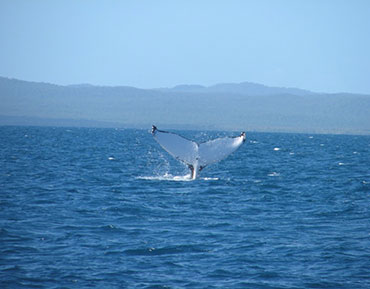K'gari (Fraser Island)
HUMPBACK
WHALES
Whale Migration
Every year over 20 000 Humpback whales migrate from their feeding grounds in Antarctica to the Great Barrier Reef to mate and give birth. Juvenile whales start appearing in Queensland as early as June. Then, the larger males and mothers make their way up the coast. Between July and August, pregnant whales give birth in the southern parts of the Great Barrier Reef and then turn south again. On their journey south, Humpbacks will stop in Platypus Bay to feed. This is also where calves are taught to hunt. On their long journey back to Antarctic waters, whales can be spotted closer to K’gari’s coast, as mothers protect their young calves.
Best Places to Whale Watch on K’gari
Indian head or Middle Rocks (Champagne Pools)
Whales use Indian Head as a navigational marker. From August to October large pods of Humpback whales are often seen heading around Indian Head and Middle Rocks. If you're patient enough, you may just see a whale breach.
Platypus Bay
Whales often make a pitstop at Platypus Bay before continuing their journey south. If you are lucky, you may see them out from Wathumba Creek.
We see the most Humpbacks in September and October.
Humpback Whale Facts
Humpback whales weigh as much as ten rhinoceros (36 tonnes) and are as long as a truck or school bus (12 - 16 metres long).
Male Humpback whales try to impress the females (cow) by slapping the water, singing and breaching.
During mating season, only the male whales will “sing”. Their whale song is thought to be the most complex sound made by any animal. One song can last for up to 45 minutes.
Whale poop is incredibly important for the ocean ecosystem. It fertilises ocean plants, called phytoplankton. These ocean plants remove carbon from the atmosphere and are responsible for producing half of the earth’s oxygen.
There are two types of whales - Toothed and Baleen whales. Humpback whales fall into the baleen category because they have fringed plates instead of teeth. They use these fringed plates to filter their food (shrimp & fish) from the water. These plates are made from a substance called baleen which is similar to fingernails.




